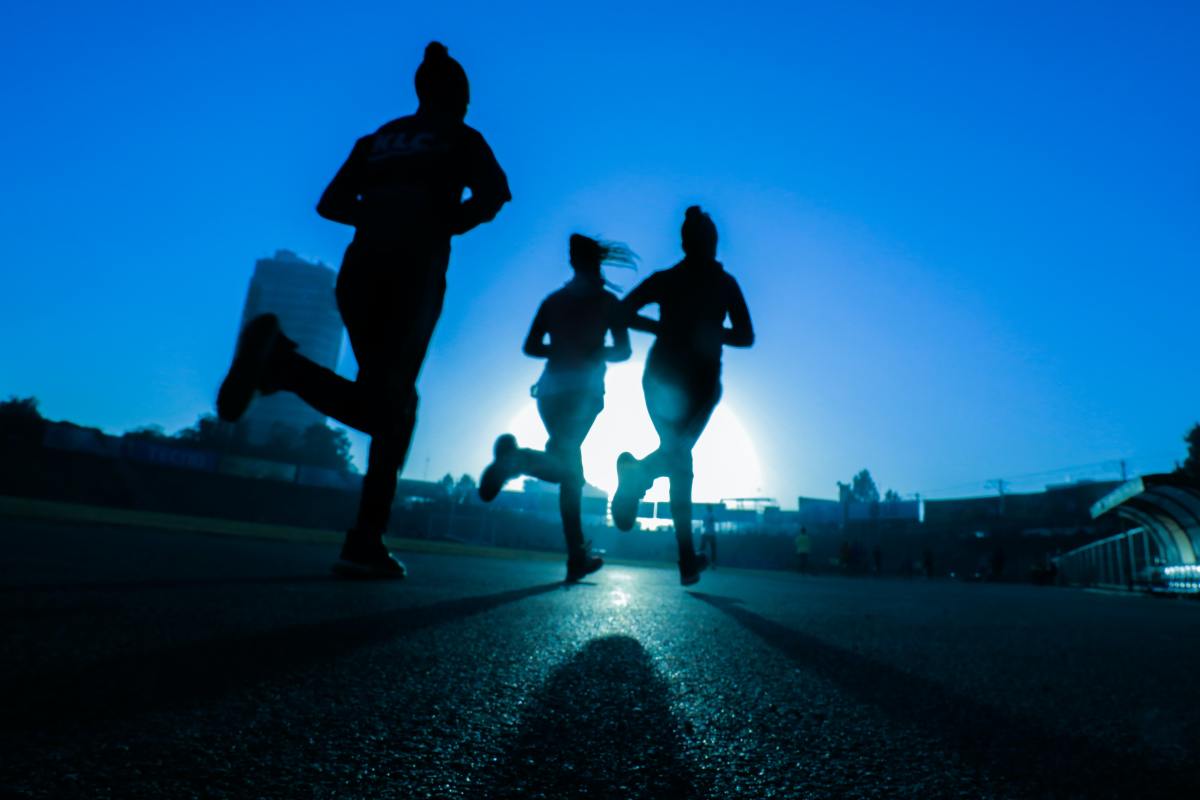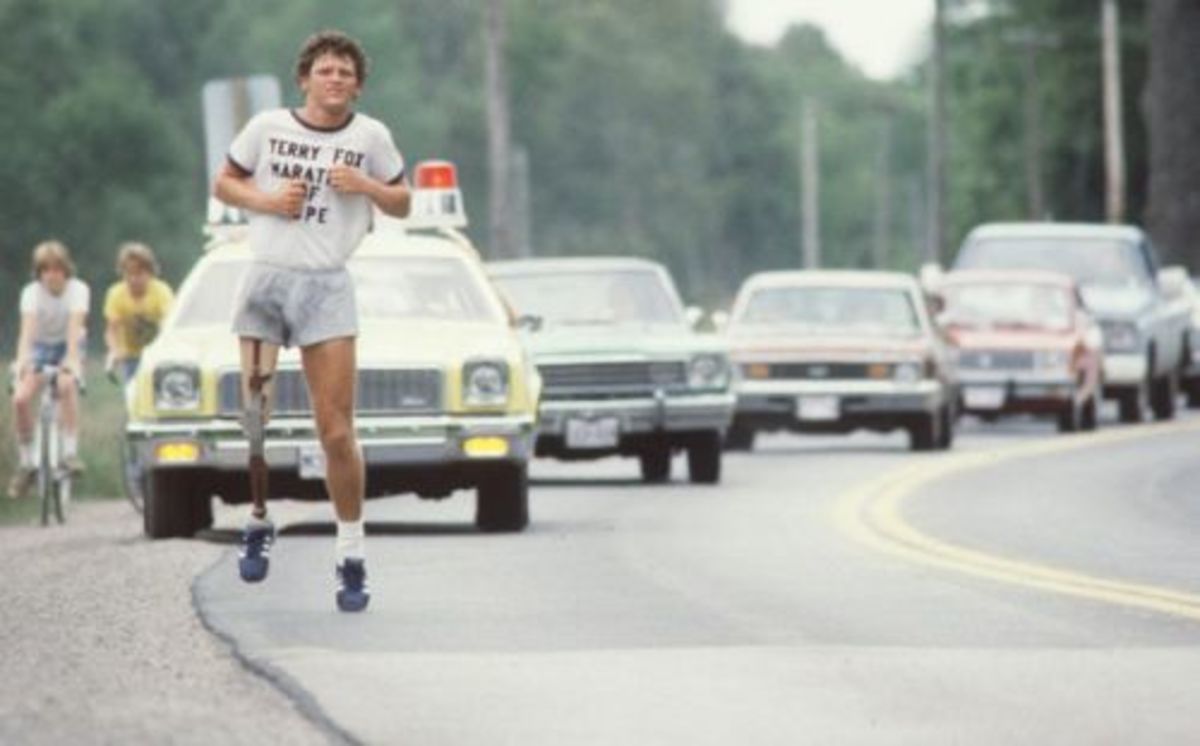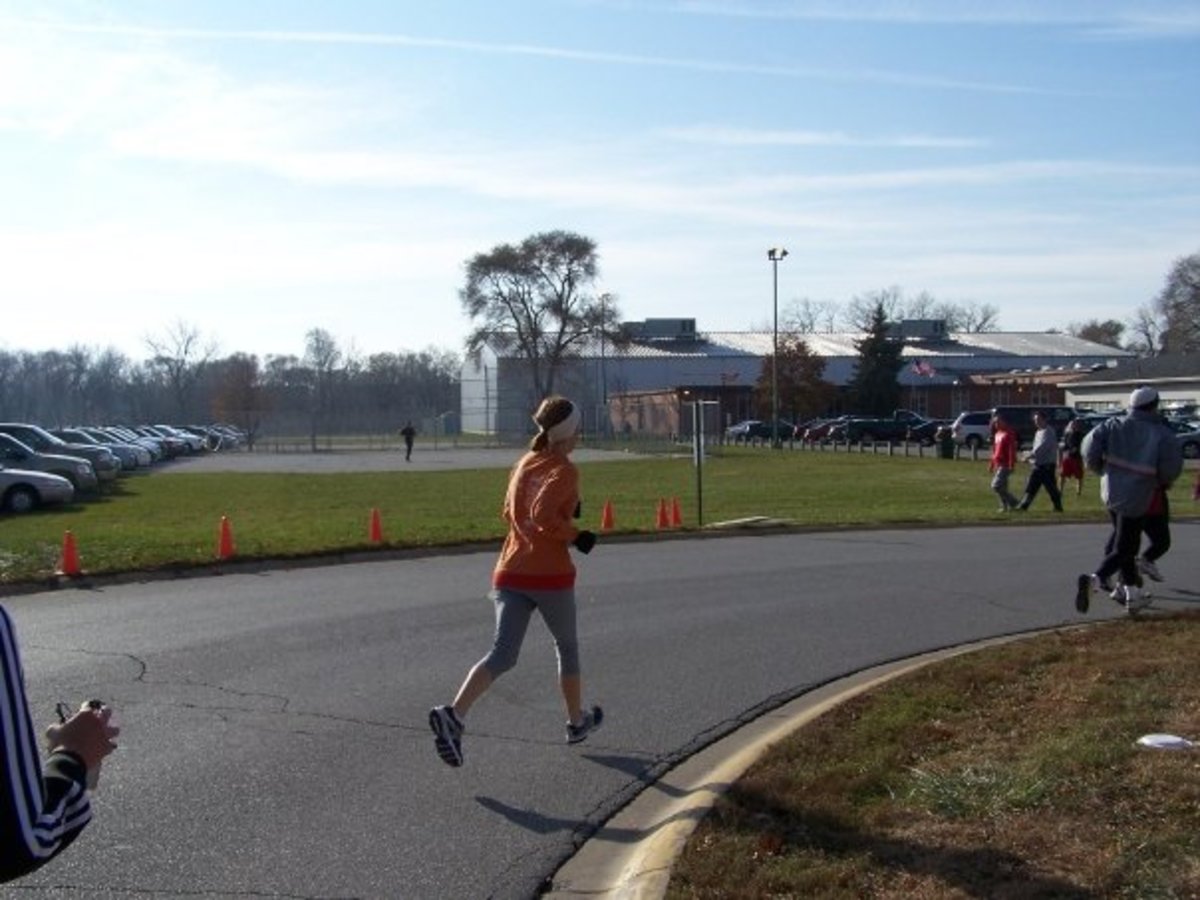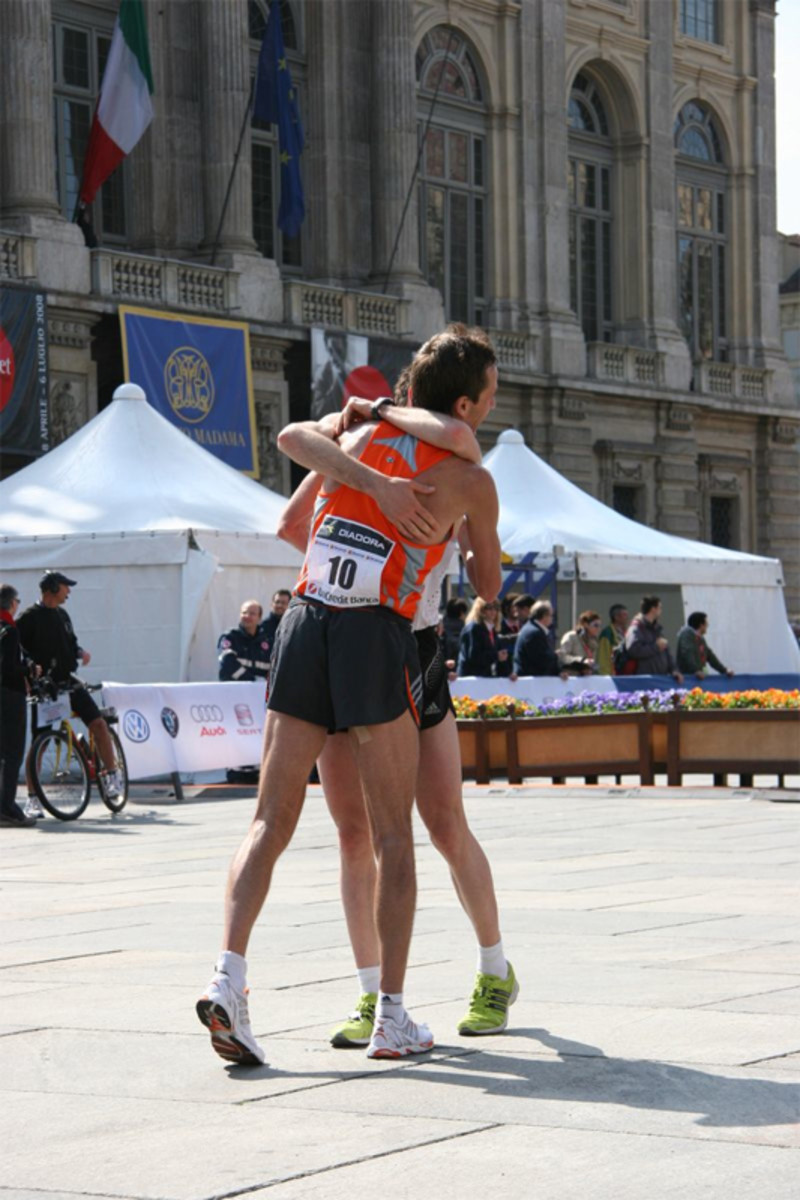Train for a 5k Race in 10 Weeks: The Beginners Couch to 5k Race Training Guide
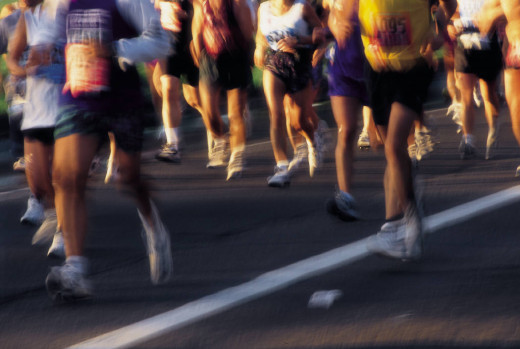
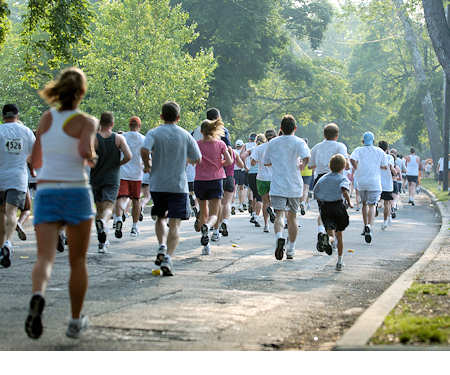
Every month, hundreds of thousands people take part in races across America, many for their first time. The popularity of these races, particularly 5K races, is ever increasing.
If you’re thinking about turning the TV off, getting off the couch and going outside for good run, there is good news and bad news.The bad news, if you haven’t actually ran since 8th grade gym class, you’re in for a surprise, your body is not as limber as it used to be. You are going to hurt, you’re going to want to quit. The good news, you don’t have to do this alone as there are thousands of people in your position, countless online forums, articles, and training guides, and smartphone apps to aid you along the way.
Whether you’re doing this because it’s always been a lifelong goal of yours to complete a marathon, or all your friends are running in races and you’re tired of being left behind, or because your doctor told you to move more, whatever your motives are, everyone is in the same boat together, starting at day 1 of training. Despite how simple running may seem, its important to do it right, especially to prevent injuries. To do this, it’s important to follow a training schedule, and get some basics down. Running in itself isn't a very entertaining pastime, and if you get hurt doing it, it’s even less enticing to engage in. The article is set up to provide information to beginning runners about how to get started, warming-up, the gear, the training schedule, as well as a resource for links to other running sites and articles.
No matter how in-shape you are, if you are not already running consistently, it’s important to start slow. If you want to train for a 10K or longer, make sure you can comfortably run a 5K first, then work your way up, don’t try to do too much too fast, these things take time. If you get winded going up a couple flights of stairs, you can’t realistically expect to be running a marathon in 10 weeks. Start slow, get the 5K under your belt, and THEN start training for 10Ks, ½ marathons, and more.
Running can be a lot of fun. Whether you just want to run around your block or through the park, or compete in a race, running is a pastime that millions enjoy, and nearly anyone can take part in. Before you start running you need to know the basics about gear, running form, and training guild lines You'll find all that and more below.
The Gear
It seems like this is a common sense thing. Shoes, underwear, shorts, that's it. However many people make mistakes when getting reading for their run, especially with what's on their feet.
Shoes
Whether you are training for a 5K, a marathon, or just some simple jogging, the most important piece of equipment by far is your shoes. A runner will need good running shoes. These shoe should only be used for running and need to be about 1/2 size larger then your standard shoe. This is because your feet will swell and they will need room to do so.
Like fingerprints, everyone foot in unique and different. therefore everyone will need a different type of shoe. Your running shoe needs to be comfortable, provide support both on the bottom, and on the ankle to prevent rolling of your ankle.
The best place is to go to a specialty shoe store that sells running shoes and get assistance from a trained sales rep. The sales rep should take in account the shape, width, and arch of your feet, as well as your foot length and type of running (off-road vs track) you will be doing before giving you shoes to try on. The salesman should also watch how you walk in order to see if your foot naturally tilts or rolls to make sure you get a shoe that stabilizes your foot.
If its not feasible to go to a specialty store, you can do it yourself. Buying your first pair of running shoes online isn't advised as you will need to try on the shoe to make its comfortable. Don't pick your running show based on the color. No one cares if you have neon green shoes if you rolled your ankle and can't use them. Try on several pairs and do some test jogs in them. Make sure there is no excess running on the toes, tops, or sides of your feet.Make sure to shoe is flexible and allows for natural movement, but doesn't extend past the normal range of motion too easy. You should replace your shoes every 400 miles, or as needed.
Adding cushioned support to your shoes will also improve how much stability your shoe provides. if possible getting a professional foot scan done at a local Chiropractic or Doctor of Podiatry Medicine office to get custom inserts is best. These inserts not only provide foot support, but also help with knee, pelvic, and low back stability as well. If not, you can stroll on down to the local Walmart and pick up a pair of Dr. Scholls.
Socks
Socks are an overlooked part of a runners outfit. choosing the wrong sock, for the wrong situation can lead to blisters, among other things. The most important factor is material. Cotton socks, while popular in the everyday world, has no place on the feet of serious runners. If cotton gets wet, from sweat or puddles, it stays wet. If this happens, it can lead to blisters. The best overall running socks are those made from materials such as polyester, acrylic, and CoolMax, because they are resistant to moisture.
After picking the material, its all runners choice from here on out. Some runners wear two pairs of socks for added cushioning, others buy socks with thickened padding for extra support. In the summer, many runners prefer thin socks for a "lighter" "cooler" feel. Its all up to you.
Everything Else
You don't need to go out and buy $120 worth of Under Armour athletic gear to start running. All you have to do is dress comfortably. In the summer, dress lightly, with clothing that is loose and breezy, and allows your body to disperse heat in warmer weather.. In cooler weather, dress appropriately, in layers if necessary. As long as your movements are not restricted, you can dress how you want. If it rains or is windy, a light rain/wind jacket is a good fit. Stores like Target, Walmart, and your local sports apparel store all will usually have a great selection on apparel priced reasonably. For the ladies, investing in a good sports bra is a must. If you sweat a lot, get some headbands,or wrist bands
For individuals with problems with chaffing on their legs, wearing underwear that fits tit around the inner thighs is best for prevention (no boxers), purchasing a pair of compression shorts also goes a long way to keep body parts from rubbing. Products like Anti-Monkey Butt powder and Goldbond Friction Stick are great to apply before running, or any workout, to prevent unwanted moisture and rubbing. If your chaffed, not only are you going to hurt, your not going to move well, or fast either.
Top Smartphone Apps for Running (Android Store)
- MapMyRun GPS Running
MapMyRun+ tracks the route, distance, pace, and more in real-time using GPS. MapMyRun brings you its mobile app for Android-based devices! Now owners of Android 2.1 or... - Nike+ Running
The most popular running app is now available on Android, for free! Map your runs, track your progress and get the motivation you need to reach your goals. No sensor o... - Zombies, Run! 5k Training - Android Apps on Google Play
The world's most epic 8-week run training program and audio adventure Zombies, Run! 5k Training is an 8-week training program and audio adventure for beginners that’ll... - C25K Couch to 5K by RunDouble
Master the Couch to 5K training program. Couch to 5K by RunDouble is a FULL FEATURED App. It Includes several different programs to meet your training needs.
Ipods, Gadgets, and Other Gizmos
We live in a technologically advanced world, and there are entire product lines dedicated to digitizing mans oldest physical activity, running. To not take advantage of all the technology out there would be a shame.
Running, especially if running on a track or treadmill, for long periods of time can get boring. This can effect your motivation. If you have an iPod or other portable music player, make a workout playlist, or put audio books on it to listen too while you run. Feel tired? Challenge yourself to keep going till the end of the song or chapter. Feeling down, crank up a positive song. Only need to run for 25 minutes? Set an alarm to let you know when to stop, so you can stop clock watching, and focus on running.The possibilities of using technology is limitless, just make sure you have comfy ear-buds.
Most of today's smartphones have a stopwatch function. These are great for keep track of your lap times. If you don't have a smartphone, a regular sports watch or an actual stopwatch work get.
Are you a tecky, who has an app for everything? Well you're in luck as the are hundreds or free and fee based apps and websites out there. These include everything from GPS trackers, and training programs, to data trackers, reminders, and more. Don't load up on apps. Do some research first and download 1 or 2 that suits your needs.
Proper Form
Before you get out the door, you need to know about running in proper form. Running in proper form will maximize your performance and even prevent injuries and falls
- Always Look Where Your Running, Not at your Feet
Keep your eyes 10-20 feet ahead of you. The only exception would be running running through some serious off road trail where foot plantation in everything.
-
Land on your Foot
Sounds obvious, but its important to land on your midfoot, not your heel or toes.
-
Keep your Feet Pointed Straight Ahead
Flaring of your feet inside or out can lead to injuries, including hip and pelvic injuries
- Keep Elbows Bent and Forearms Waist High
Don't hold your hands near your chest. this does not help you breath better or prevent tiring. It can actually make you more tired and increase the tension in your upper body
- Don't Swing your Elbows
Swing arms from the shoulders
- Maintain Proper Posture
While Running, you should have straight and erect posture throughout your run. Your shoulders should be square, below the ears, your back straight with no leaning, tilting, or hunching. Same with your pelvis, straight and upright.
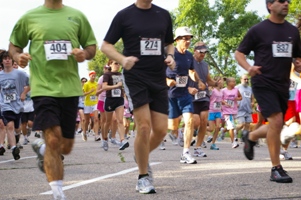
Nutrition
Probably the most overlooked part of training for 5K races, and others, is incorporating appropriate nutrition into your training routine. Eating healthy will definitely help with your training. These are some steps you can and should take to help your body react to the stresses you will put on it.
- Cut back on fat, particularly trans or saturated fats
- Increase your intake of complex carbs (not carbs from pop or candy bars). Complex Carbs, from foods like whole grains, fruits, and veggies, provide the body the energy it needs for, well everything . When you run out of carbs, you can’t move (search "hitting the wall on youtube) . Forget about what Dr. Atkins said, without carbs, you can’t run for very long. At least 50-60% of your daily calories should come from complex carbs, with 25-30% from protein, and the rest from fats.
- Vitamins and Supplements. Taking a daily multivitamin will definitely help. If you’re worried about joint pain. Taking Glucosamine and Chondroitin will aid in keeping your joints limber by protecting, lubricating, and cushioning cartilage, Adding MSM to this blend goes even further to helping maintain joint comfort and elasticity If price is an issue, at least consume adequate amounts of Vitamin C and Vitamin E. Vitamin C helps with cartilage (joints) as well as boosting your immune system and Vitamin E has been shown to help with Shin Splints, which are a runners nightmare.
- Hydration, Hydration, Hydration. Believe it or not, Soda and Alcohol do not hydrate you. If you are going to be running, you need to drink water, and lots of it, as well as some sport drinks like Gatorade, during and after training to regain the electrolytes lost during training. You don’t need to cut Soda and Alcohol out of your diet completely, however as it gets closer to race day; you should increasingly limit your consumption.
- Don’t eat large amounts of protein before running or any type of physical training. Protein is hard to digest and uses lots of water to do so. This takes water away from the parts of your body that need it during exercise and can result in increased cramping. However, consuming protein after running or working out is a must. Protein will help heal and rebuild the muscle and tissue after working out.
The Warmup
Before you begin any physical endeavor, a proper warm-up is necessary. Not warming-up your muscles before a workout is a leading cause of injury during the workout itself. It’s important to include all parts of your body in the warm-up as well as making sure the main muscle groups being used in the workout are properly warmed up.
One common misconception about pre-workout warm-ups is stretching. Many people will stretch first, then warm up This is a mistake. Without going into too much muscular anatomy, each muscle has sensors that control how far they will stretch before signaling pain to the brain. If the muscles are not warmed up, these sensors will still be keeping the muscle fibers, as well as tendons and ligaments at a higher degree of tension, and over-stretching will cause injury. The more warmed up a muscle is, the more the sensors allow it to move before signaling pain. You should always do a light warm up before stretching. In the weekly training guide below, the (WARMUP) refers to this warmup noted here.
Start at the top and work your way down. Following this warm-up guide will get your body properly prepped.
- HEAD ROLLS: Tilt your head so your Right ear is going down towards your shoulder. Don’t force it. Let it hang so gravity will gently pull it closer. Hold for about 10s, then SLOWLY roll your head to the left, with your chin tucked tightly to your chest until your Left ear is over your left shoulder. Hold for another 10s, then roll back. Repeat 5x, then roll with your chin up in the air 5x
- ARM CIRCLES. Hold your arms straight out, even with your shoulders like a soaring eagle. Move each arm in a forward direction so your hands are forming a circle. Start small and about every 15 – 20s get bigger until you are making the biggest circles possible. After about a total of 90s. Stop; shake your arms out, and repeat, going in the reverse direction.
- JOGGING IN PLACE: Since this is an article about running it is even more important to get your lower limbs warmed up. Start with a light jog in place, keeping your knees low, work your way up to achieving a steady pace with your knees going waist high. Keep this up for about 30s-45s, then slowly bring yourself to a controlled stop.
- CALF KICKS: Similar to jogging in place, except instead of your knees going up, they stay almost stationary, while your ankles and calves kick up towards the ceiling all while staying in place. Work towards getting them up as high as possible at a steady pace, hold for 30s-45s, then slowly bring yourself to a controlled stop.
- JUMPING JACKS: Finish your pre-stretch warm-up strong with Jumping Jacks and Wacky Jacks. Do normal Jumping jacks for 60s, then 45s of Wacky Jacks, then repeat the cycle 2-3 times. Once complete you are all warmed up and ready to stretch. If you feel like you need more warming up, just repeat the exercises over again.
Stretching
After your warm-up, continue your pre-workout routine by doing the following stretches. What is equally important, if not more is stretching after your main workout. Repeat the following during your cooldown period following the day’s workout. The stretches should focus on your hamstrings, quads, calves, and inner groin muscles, as well as your arms, and torso. Hold each of the poses for 30 – 60s. It should “be uncomfortable”, but not painful. If it hurts, relax a bit. Repeat each of the stretches at least 2x.
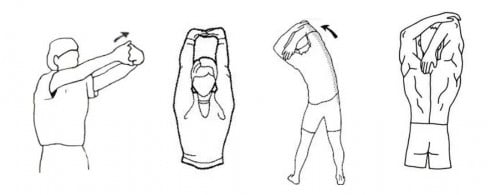
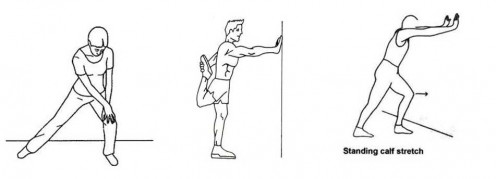

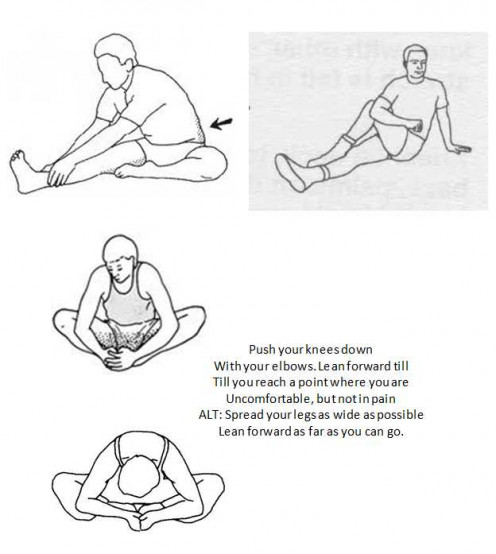
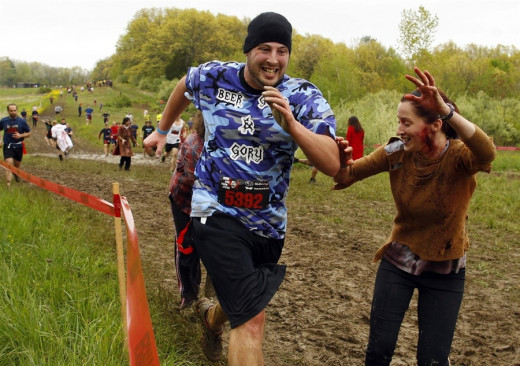
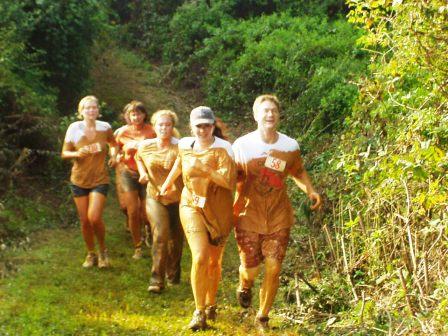
Train Appropriately
Today, themed races are popping up all across the Country. From Tough Mudder and Warrior Dash, to the Mud Run, and Run for your Lives, running is no longer about running around a few city blocks, its about surviving. If you are going to be running in one of these themed obstacle courses, you need to train for it. You may be able to run 16 laps around a flat track just fine, but that training will not help you at all when you come to a hill, obstacle, or steep grade on the trail on race day.
If this is the type of race you’re doing, start running outside, on off road trails if possible, if not go to a neighborhood that has steep inclines. Practice jogging up these hills over and over, feel the burn and incorporate this type of training into your weekly routine. For races like Run for your Lives where you are being chased, not only is training off-road important, wind sprints are equally important. Many runners participating in events like this fail to train for it. They can easily jog a 5K or more, but after the first time they sprint hard for 60meters trying to escape, they are winded, out of breath, and unable to even jog. Go to your local park, sprint for 5-10s, walk back and repeat. Keep doing this and eventually transition into sprinting for 6 seconds, then jogging at race pace for 3-5mins, then sprinting again, all without stopping.
Research your event. Find out how long it is, if there are obstacles, or hills, or zombies, then train for it specifically. If you need to jump, practice jumping, if you need to slide, practice sliding. If you find out you need to use any upper body strength, start lifting some weights or doing push-ups and etc. If you are training for a triathlon, cardio is definitely key, but don’t forget to ride your bike, swim, and lift weights accordingly.
Training isn't key, training appropriately is. This is not only important to complete the event, but also so you don’t injure yourself trying to do something you didn't train for.
The 5K Training Guide
There are plenty of guides out there that give you instructions on ways to go from the couch to competing in a 5K in 5weeks. If one is committed, and has the time, this is a solid way to go. However, pushing one’s self too hard and result in injury, which will stop your training, and a lot of people will give up and stop. To keep people motivated without overstressing their bodies, this article focuses on a 10 week + training guide for getting to a 5K.If, you are looking for a more advanced challenge and can already run a 5K, alternative training guides are available for Advanced Beginners, Intermediate Runners, 10k training, and more.
The below guide is a recommended schedule. It’s not set in stone. Think of It as “open source” Depending on your degree of physical prowess, you may need to tweak the suggested training schedule. Some may need to take it slower, or repeat some of the weeks before moving on to the next level. That’s ok, consistency is the key. Repeating Week 3 over again before moving to Week 4 is perfectly acceptable! Others will be able to go harder or faster during the first couple of weeks. That’s ok too, as long as you’re not skipping ahead. You can still pace yourself and instead of jumping ahead, work on running at race pace before slowing down or walking, or going for a longer time. Ex: If 15mins is too short, go 20, if 4 cycles is not challenging enough, go 5 or 6, if you think you can jog faster, or even run, then jog faster or run for stretches of your workout, again consistency is key. Keep track on how well you do and if you made any modifications.
A Simple search of the internet will yield hundreds of couch to 5K, 5 weeks to 5K, and etc training schedules and plans. Feel free to search for a guide that fits your needs. If you are struggling to run 1 mile, this link takes you to a 1 mile in 6weeks training schedule. This guide below is just one of many out there for training for a 5K in 10 weeks. Pick one that fits your need sand style.
WEEKS 1, 2, and 3
Weeks 1, 2, and 3 are the most important of your training, because it will be in easiest period to quit in. In these weeks, if you are new to running, you will hurt in places you never knew existed, you may cry, you will cuss and shake your fist at the Almighty. Many people will want to quit, but you’re not going to be one of them. Make a commitment to yourself. Realize some pain is good pain, that it means your accomplishing something. If that’s not enough, find an accountability partner, someone who will knock at your door on a Saturday morning at 5:00AM and drag you out of the house to the track (or wherever). In each of these workouts, you should be covering around .75-1 miles in distance between walking, jogging, and running
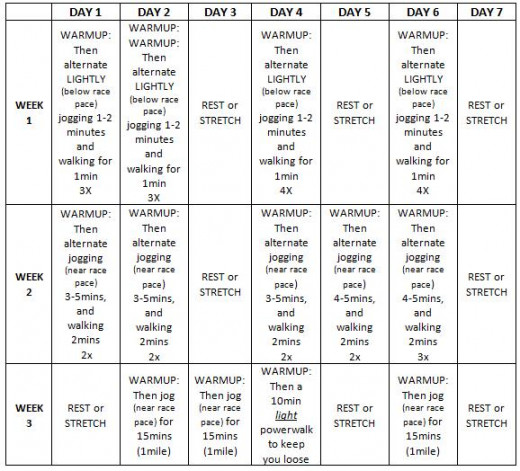
WEEKS 4-5
Weeks 4-5 work on building up distance and getting to race pace. These workouts will be faster and longer then in weeks 1, 2, and 3, but your body has now been, so it won’t be as big of a shock. Remember, if you’re having trouble staying at pace or keeping it up, don’t give up. Slow down, take a break, and most important, keep moving to increase your body’s cardio ability.
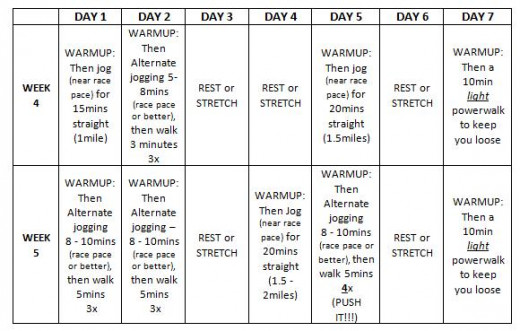
WEEKS 6 and 7
Weeks 6 and 7 gets up to near 5K distance and also starts incorporating Interval Workouts (IW). IWs are designed to increase your cardiovascular endurance and speed. These work by running hard for a given time or distance, then walking till you’ve caught your breath, then repeating the cycle over again. If you are unable to run or sprint, you may do the optional workout plan listed. In this workout schedule we will use time as the factor for IW. Example a 4 X 10s means jog/run well above race pace (near sprinting) for 10s, then walk 30 -60s, then repeat for a total of 4 cycles. If you need more time to catch your breath afterwards, take it.
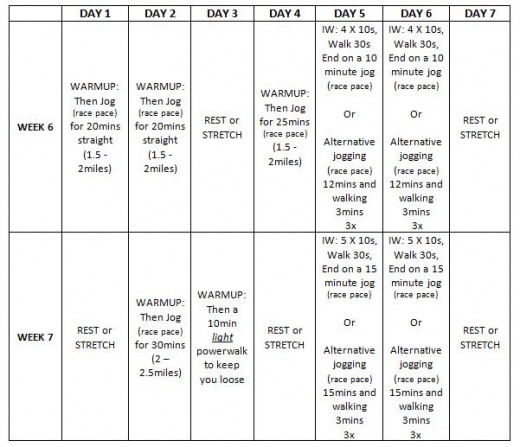
WEEKS 8, 9, & 10
This is it!!! The final stretch!!!! These last 3 weeks increase the IW, gets you 5K consistently (and more), and also works to increase your race pace. Remember, its ok to repeat some weeks. If week 6 or 7, or even week 2 was too tough, its ok to keep repeating those weeks until you feel like you’re not challenged anymore before moving on to the next week. As long as you are consistent, you will get better, and better.
Remember, on the week of your race, take at least 2 days off before your race event to rest your legs, and do lighter workouts on the 2 days before that. Drink lots of water and make sure you have enough carbs to eat on the day prior to race day. When you actually race, make sure to pace yourself. It doesn't do any good to come out strong and then struggle to finish.
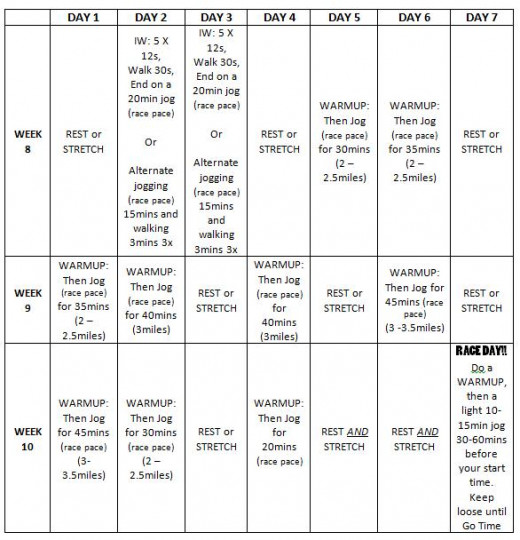
Pain and Injuries
Unforgettably, pain and injuries are a risk to all who are physically active.They happen, even to the most well-conditioned athlete. If this happens to you, don't be discouraged or stop being active all together. Do the proper steps to heal, then get back in the game.
Many people ask if running through pain is a good thing. The answer is no. Pain happens for a reason. Its your bodies way of telling you something isn't right, and you need to pay attention to it. To help prevent serious injuries, you need to be aware what your bodies telling you while your running, and after.Yes, sometimes its not a big deal, or minor modifications can resolve the issue, but other times, it is a big deal and ignoring it can lead to bigger problems.
If you feel any sort of chest pain or are having trouble breathing you should stop immediately, and give your body a chance to relax. If it doesn't go away in a few minutes, contacting a Doctor is highly recommended.
The next day, after a hard workout, or especially when you first start running, being sore and stiff afterward is very common. Your muscles will ache, feel uncomfortable to move, be sore in general. This typically is a good hurt (beware tho, if you have really severe shooting pain, you may have a strained or even torn muscle, take the appropriated action). If its just the good hurt, do an extra good job of stretching before you do any more activity, taking a hot shower or bath can also help. Certain bath salts used while taking a hot bath, can help relieve the pain as well. Topical creams such as biofreeze and icy-hot also help relieve the aches.
Muscle cramping is one of the more common types of pain that occurs while working out and in the cool down and recovery period. While this pain is sharp, its generally not a major concern. Keeping hydrated with H2O and electrolytes like potassium, as well as proper stretching will help prevent cramping. When it does happens, do whatever you can to relax and stretch out the affected area. Take a hot bath or shower if possible to sooth the muscles. If the cramping keeps returning, stay off the affected area and keep it in a relaxed, non contracted state. A good nights sleep and more hydration should do the trick.
Two other common discomforts running will run into are "runner's stitch" and "shin splints" Runner's Stitch is characterized by a very sharp, stabbing pain, underneath your rib cage on the right and left lateral side. More often then not, the pain is present on the right side. While the exact cause us unknown; most experts agree that is has something to do with your diaphragm Your diaphragm is the muscle that allows you the breath. Its contracted on every breath you take in, and relaxed when you fully exhaled. Since you breath harder and faster while running, and most people don't fully exhale while running hard, the diaphragm is never relaxed, overworked, and prone to cramping, hence runner's stitch.
The other theory on why it occurs on the right side more often has to do with again your diaphragm, and your liver. Your diaphragm has multiple tendons and ligaments coming off of it that attach to your internal organs, including your liver. The forceful contractions may yank on these ligaments and pull on the liver causing pain to be felt by the liver. Evidence also shows that the liver itself can contract to push extra oxygen-carrying red blood cells into your system and this extra work can cause the pain. If this occurs to you, the best way to alleviate the pain is to slow down or stop, take in deep breathes and FULLY exhale to bring your diaphragm to a relaxed state. Putting pressure with your hand where it hurts can also help. It will take sometime, but the pain should start to subside in 60-90s.
Most athletes will develop shin splints at one time or another. Shin Splints, or tibial stress syndrome isn't a medical condition itself, but rather a symptom of an underlying problem. Common conditions resulting in shin splints are, irritated or swollen muscles, typically caused by overuse, stress fractures, or running with an overpronation or "flat feet"
Shin splints cause a dull, aching pain in the front of the lower leg, especially when putting any stress on the area. The pain is usually located on either side, or both sides of the muscles surrounding the shin, and can be painful to pressure. Some people develop it while running, others may not notice it till after they have stopped. Runners typically develop them when they increase their workout intensity or change to running on a harder surface, like cement or asphalt.
Typically, shin splints are not a major problem, but severe shin splints can cause more complicated problems like fractures. If you get them, its best to take it easy and rest. Icing the muscles around the shin for 20-30 mins every few hours can help, as well as taking over the counter anti-inflammatory and pain killers. Wearing a neoprene sleeve to warm and protect the leg can also help as well as taking Vitamin E supplements.
The good thing about runner's stitch and shin splints is that your body can be conditioned to not get them. While these problems will be common while first starting out, the more you work your body, the stronger it gets, and the less likely these problems will develop. Sticking to the warm-up and stretching schedule will also help prevent these injuries.
For more major injuries like ankle rolls, muscle strains, and tears. Immediately stop the workout, running through the pain will only make the problem worse. Ice the affected area, keep it elevated, and if it's a muscle strain, try to keep from using that muscle. If you have any concern or questions about your injuries or pain you are feeling, do not hesitate to call a Doctor for advice.


